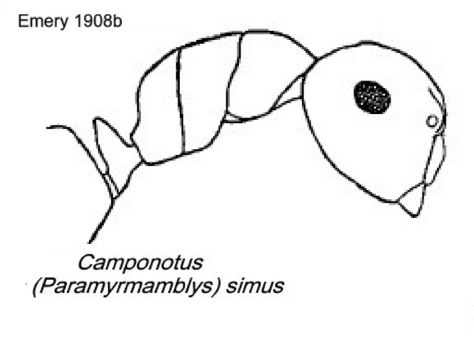Camponotus (Paramyrmamblys) simus Emery
  Type location Zaïre
(Emery, 1908b: 188, illustrated, major & minor workers & queen)
collected
at Sankuru, by Luja - see below Type location Zaïre
(Emery, 1908b: 188, illustrated, major & minor workers & queen)
collected
at Sankuru, by Luja - see below
subspecies manidis (Camponotus
manidis n. sp., Forel 1909b: 62, major & minor workers ; Camponotus
simus Em. subsp. manidis
Forel, Forel, 1911f: 282) from Zaïre, lower Congo, from stomach
of Manis
temmincki, collected by Solon - see http://www.antweb.org/specimenImages.do?code=casent0910560
major & minor workers & queen (see
Bolton, 1995)  . .
|
 Emery's
(1908b) description is at Emery's
(1908b) description is at  . Santschi (1926c) gave a description is at . Santschi (1926c) gave a description is at

Forel (1911f) writing of manidis Forel, from Bas
Congo, noted that he had compared the form with the type from Emery - manidis
differed consistently in the head being less truncated anteriorly; the
colour was clearer brown and the pilosity a little more abundant and
more erect on the tibiae.
In 1909, he had described manidis as - TL 4-6
mm; MAJOR - mandibles slender, slightly shiny, sparsely punctate,
finely shagreened and with 5 teeth. Clypeus double indented, slightly
forward medially, faintly subcarinate posteriorly, Head trapezoidal, a
little longer than wide, widened and strongly impressed posteriorly,
sides quite convex; frontal area very small, frontal carinae strongly
divergent and sinuous. Eyes forward of posterior one-third. Scapes
scarcely passing the occiput by less than their width. Funiculus
segments a little longer than wide. Alitrunk fairly short, barely
convex in all directions, without a suture. Posterior to metanotal
suture, the propodeal dorsum is raised slightly but barely depressed or
bordered, rectangular, 60% longer than wide; curving into the declivity
which is of similar length. Petiole biconvex, rounded and truncated on
top, of medium thickness. Femora short, tibiae cylindrical, without
spurs.
Shiny, very finely and feebly shagreened; piligerous puncturation
sparse but distinct, specially on the front where the punctures are
large. Genae without any large punctures, nor on the dorsum of head,
similar to foraminosus. Erect pilosity yellowish red, abundant
or at least moderately so on the entire body; on the tibiae and scapes
this pilosity shorter and oblique, but still abundant and distinct.
Colour brown or brownish yellow; appendages red or yellow brown.
MINOR - overall similar, mandibles with 5 teeth, clypeus more carinate
posteriorly. Head also trapezoidal; widened posteriorly; only slightly
longer than wide, but sides less convex and posterior border near
straight. Dorsum of propodeum straighter, twice as long as wide.
Petiole scale more convex anteriorly.
Particularly characterised by its pilosity.
|